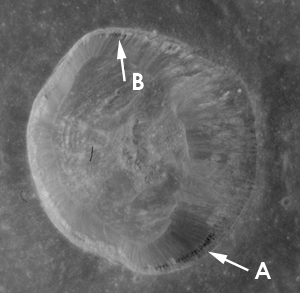
| Project Home | About the Scans | Browse Gallery | Image Map | Support Data | Resources | Ephemeris |
Featured Image - 05/13/2008
Apollo Images Help New US Lunar Mission Scout the Next Frontier
Apollo orbital images are being used to help target observations for the Lunar Reconnaissance Orbiter Camera (LROC) Narrow Angle Cameras (NAC) onboard the Lunar Reconnaissance Orbiter, which is scheduled for launch in October of 2008. There are two LROC NAC instruments. Each NAC has a resolution of 0.5 meters per pixel and a foot print of 2.5 kilometers crosstrack by 25 kilometers downtrack (combined footprint of 5 km by 25 km). As we get closer to the launch of the Lunar Reconnaissance Orbiter later this year, the LROC Science Team is diligently looking for the best areas to image using the NACs to help NASA prepare for future human lunar exploration. To do this, we are using all of the available data from previous lunar missions.
What are the advantages of combining datasets?
Dawes Crater, an approximately 18-kilometer diameter and 2-kilometer deep crater, is located in Mare Serenitatis, east of a contact between dark and light mare material (you can see this contact in the Apollo metric frame shown in Figure 1). In Figure 2, a Clementine UV/VIS ratio image, you can clearly see the contact between the dark (blue) and light (orange) mare material. The blue portions of the image represent younger, iron-rich, high titanium material, while the orange portions represent older, iron-rich, low titanium material. Clementine data (with a spatial resolution of about 100 m/pixel) is able to resolve the regional details of this area, but higher resolution details are not discernable. However, when you use the higher resolution Apollo metric frames (with an approximate resolution of 10 m/pixel), you can see smaller details. For example, examining Dawes crater at full magnification reveals interesting details, such as unusual dark (black) material in the crater wall (see Figure 3 below).
|
Figure 1 - Apollo Metric AS15-M-1801 showing contact between different mare materials as well as Dawes and Plinius craters [NASA/JSC/Arizona State University] |
Figure 2 - Clementine UVVIS ratio image of area shown in AS15-M-1801 [NASA/Clementine/USGS] |
In the close-up view of Dawes crater (Figure 3), many interesting details can be seen. For example, dark material exposed by slumping of the crater wall can be clearly seen (arrows A and B). Also evident is the swirling pattern of the materials in the floor of the crater, as well as the gully-like features in the walls that have been proposed as analogues to martian gullies. A NAC observation would be able to image the center portion of the crater, from the north rim to the south rim, but would require two or three observations to complete the coverage from the west rim to east rim.
Figure 3 - Close up view of Dawes Crater, showing dark material in crater wall [NASA/JSC/Arizona State University]
References:
Don E. Wilhelms, 1987, The Geological History of the Moon
Clementine Color Ratio Data Set
G. Bart, 2006, Comparison of small lunar landslides and martian gullies

|
|
Space Exploration Resources |
|
 LPI LPI
|


